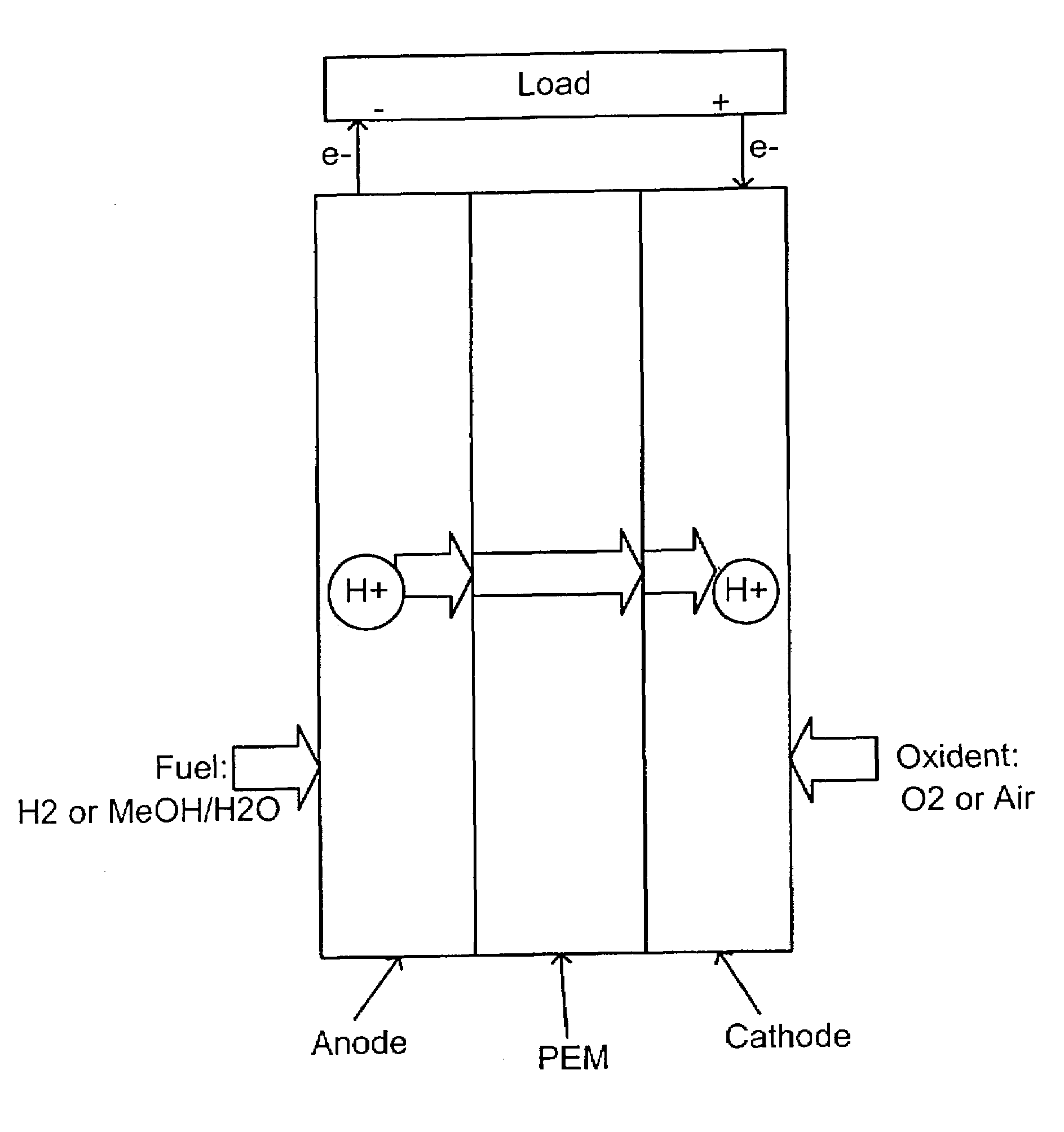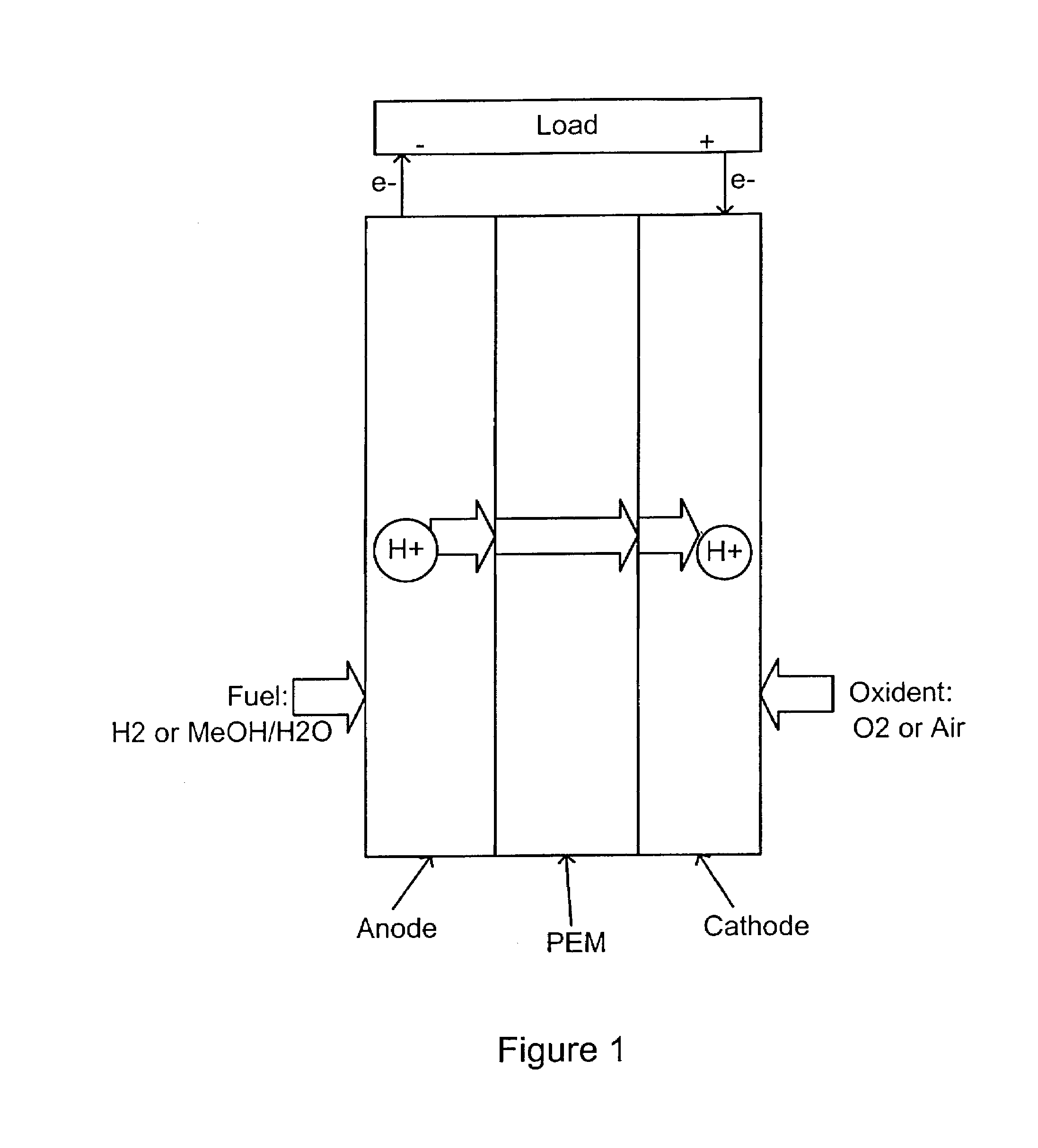Acid-base proton conducting polymer blend membrane
a technology of acid-base proton and polymer, which is applied in the direction of non-aqueous electrolyte cells, cell components, electrochemical generators, etc., can solve the problems of affecting the application of high temperature hydrogen/air polymer electrolyte membrane fuel cells, affecting the application of dmfcs, and high manufacturing cost, etc., to achieve good water retention ability, reduce methanol permeability, and good water retention ability
- Summary
- Abstract
- Description
- Claims
- Application Information
AI Technical Summary
Benefits of technology
Problems solved by technology
Method used
Image
Examples
example 1
[0067]0.7 g of sulfonated polyetheretherketone (SPEEK) was dissolved in 12.0 g of dimethylacetamide (DMAC). To this solution was added 0.2 g of ammonia, and then 0.3 g of poly(styrene-b-4-vinylpyridine) (Mn of polystyrene block=160K, Mn of polyvinylpyridine block=80K). The resulting homogeneous solution was cast at room temperature into a 12.5 cm×12.5 cm mold. After drying at room temperature, the polymer membrane was soaked in 1.5M sulfuric acid solution for 16 hours, and finally rinsed with deionized water.
[0068]The polymer membrane was swollen in water at room temperature (water uptake 24%). The polymer membrane conductivity was measured by AC impedance. The polymer membrane was swollen in 4M methanol aqueous mixture at 80° C. for 24 hours to measure the expansion stability. Methanol crossover was measured in 4M MeOH using H-Cell, and the permeation rate was obtained by gas chromatography analysis.
example 2
[0069]0.8 g of sulfonated polyetheretherketone (SPEEK) was dissolved in 14.0 g of dimethyl acetamide (DMAC). To this solution was added 0.3 g of 30% ammonium hydroxide, then 0.2 g of poly(styrene-b-4-vinylpyridine) (Mn of polystyrene block=160K, Mn of polyvinylpyridine block=80K). The resulting mixture was stirred overnight. The resulting solution was cast onto a 5″×5″ glass frame. The membrane was dried at room temperature for two days, then vacuum dried at 60° C. for 8 hours. The resulting membrane was soaked in 1.5M H2SO4 at room temperature overnight. The membrane was then rinsed with deionized water to remove any traces of acid.
example 3
[0070]The same procedure was employed as in Example 1 except that 0.9 g SPEEK, 15.0 g DMAC, 0.3 g ammonia, and 0.1 g poly(styrene-b-4-vinylpyridine) (Mn of polystyrene block=160K, Mn of polyvinylpyridine block=80K) were used.
PUM
| Property | Measurement | Unit |
|---|---|---|
| temperature | aaaaa | aaaaa |
| conductivity | aaaaa | aaaaa |
| conductivity | aaaaa | aaaaa |
Abstract
Description
Claims
Application Information
 Login to View More
Login to View More - R&D
- Intellectual Property
- Life Sciences
- Materials
- Tech Scout
- Unparalleled Data Quality
- Higher Quality Content
- 60% Fewer Hallucinations
Browse by: Latest US Patents, China's latest patents, Technical Efficacy Thesaurus, Application Domain, Technology Topic, Popular Technical Reports.
© 2025 PatSnap. All rights reserved.Legal|Privacy policy|Modern Slavery Act Transparency Statement|Sitemap|About US| Contact US: help@patsnap.com



